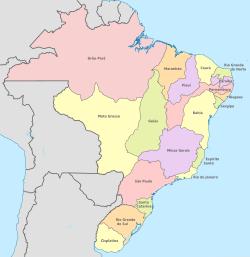State_of_Brazil
State of Brazil
1621–1815 state of the Portuguese Empire
The State of Brazil (Portuguese: Estado do Brasil) was one of the states of the Portuguese Empire, in the Americas during the period of Colonial Brazil.
You can help expand this article with text translated from the corresponding article in Portuguese. (October 2023) Click [show] for important translation instructions.
|
This article needs additional citations for verification. (January 2022) |

